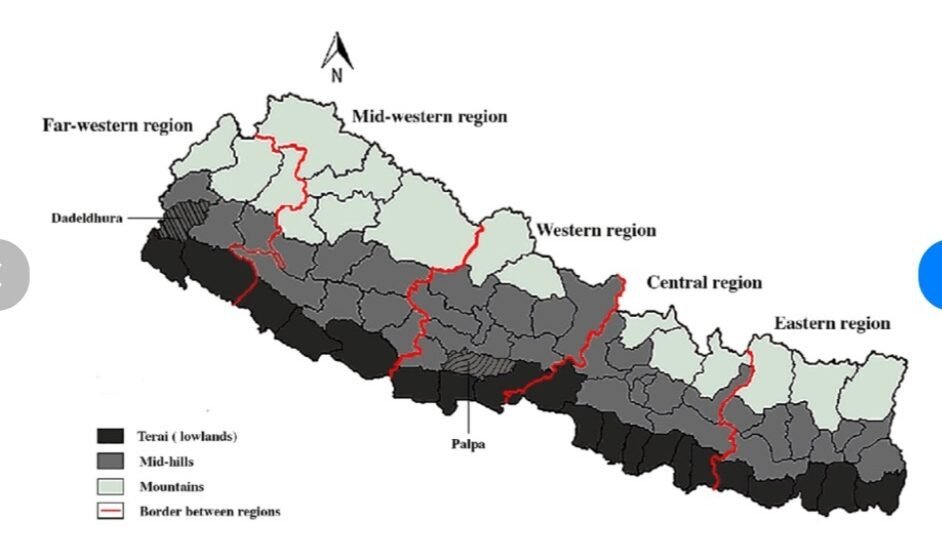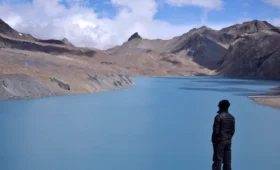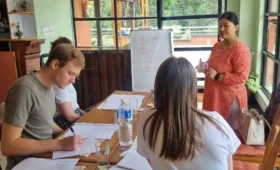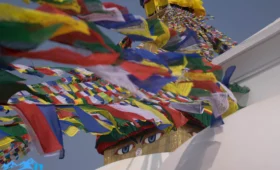Geography of Nepal
Nepal is located in South Asia, bordering China to the north and India to the south, east and west. The total land area is 147,181 sq. km. Geographically Nepal spans about 800 km east to west along its Himalayan axis, and 150 to 250 km north to south, and is vertically intersected by multiple river systems. The country is typically divided into three main geographic regions: the Himalayan region, the Hills region and Terai region. The highest point in the country is Mt. Everest (8,848 m) which is also the highest peak on earth, while the lowest point is in the Terai plains in Jhapa, which is only 60 meters above sea level.
The Terai region occupies about 17 percent of total land area of the country. Kechana Kalan, the lowest point of Nepal with an altitude of 60 m, lies in Jhapa district of the eastern Terai. The southern lowland Terai continues to the Bhabar belt covered with the Char Kose Jhadi forests known for rich wildlife. Further north, the Siwalik zone (700 1,500 m) and the Mahabharat range (1,500 2,700 m) give way to the Duns (valleys), such as Trijuga, Sindhuli, Chitwan, Dang and Surkhet. The Midlands (600 3,500 m), north of the Mahabharat range is where the two beautiful valleys of Kathmandu and Pokhara lie covered in terraced rice fields, and surrounded by forested hills.
The Himalaya region (above 3,000 m) comprises mountains, alpine pastures and temperate forests limited by the tree-line (4,000 m) and snow line (5,500 m). Eight of the fourteen 8000 meter peaks of the world lie in Nepal: Sagarmatha or Mount Everest (8,848 m), Kanchenjunga (8,586 m), Lhotse (8,516 m), Makalu (8,463 m), Cho Oyu (8,201m), Dhaulagiri (8,167 m), Manaslu (8,163 m) and Annapurna (8,091 m). The inner Himalayan valleys (above 3,600 m) such as Mustang and Dolpa are cold deserts sharing topographical characteristics with the Tibetan plateau.
Amongst its mountains, Nepal has around 6,000 rivers that are snow-fed or dependent on monsoon rainfall. The larger rivers include Mahakali, Karnali, Narayani, and Koshi, all of which originate in the Himalayas. Medium sized rivers are the Babai, West Rapti, Bagmati, Kamala, Kankai, and Mechi, all of which originate in the midlands or Mahabharat range. Additionally a large number of season streams, mostly originating in Siwaliks, flow through the Terai.
There are more than 30 natural caves in Nepal out of which only a few are accessible by road. Maratika Cave (also known as Haleshi) is a pilgrimage site associated with Buddhism and Hinduism. Siddha Cave is near Bimalnagar along the Kathmandu-Pokhara highway. Pokhara is also known for caves such as Bats shed, Batulechar, Gupteswar, and Patale Chhango. The numerous caves around Lo Manthang in Mustang include Luri and Tashi Kabum which house ancient murals and Buddhist chortens dating back to the 13th century.
Real Journey Trekking Nepal does not only offer the most popular and wide range of hiking, trekking, peak climbing, mountaineering, kayaking, rafting, and various trekking programs but also offers the opportunity to volunteer in schools, health institutions, disability centers, construction, women’s programs and many more before, during or after your trek.
We are here to offer your something different which truly connects with local Nepali people and immerse yourself in their lifestyles and culture while you travel.
Real Journey Trekking Nepal was founded in 2006 to create real, authentic experiences in Nepal for travellers and trekkers around the world who also wanted to give back to the local communities through ethical trekking or combining volunteering with travelling in Nepal.
At Real Journey Trekking Nepal, we want you to see what your money is funding and to spend time visiting our local projects and with the local Nepali people that you are supporting. Over the past few years, we have been providing food, clothing, and educational sponsorship to more than 50 orphan children.
Through our women’s development project, 30 women in Kathmandu are currently receiving day to day literacy and language classes along with skill training. We are proud to have been running a disabled centre with a capacity of 25 children that provides services such as special education, physiotherapy and speech therapy.



